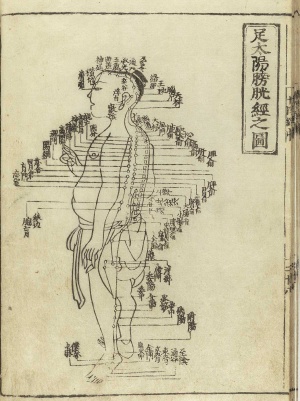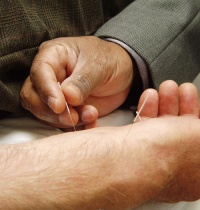Acupuncture
Original Editor - Admin - Rachael Lowe
Top Contributors - Admin, Kim Jackson, Kalyani Yajnanarayan, Vanessa Rhule, Naomi O'Reilly, Chelsea Mclene, Laura Ritchie, WikiSysop, Evan Thomas, George Prudden and Carl Clarkson
History of Acupuncture[edit | edit source]
Acupuncture forms part of traditional Chinese medicine (TCM). Various sources have proposed that acupuncture dates back to anything from 3000BC to 1000BC[1].
Traditional Chinese Acupuncture[edit | edit source]
One of the more intriguing aspects of acupuncture is how it gradually made its way from Chinese folk medicine, to its present day position as one of the most popular, evidence-based interventions for a whole host of ailments[2]. Acupuncture is likely to have begun with whittled stone, bamboo, and fish bones, before progressing to metal probably around 400 BC, yet its prominence throughout Chinese history is irrefutably omnipresent.
For more on the history of Traditional Chinese Medicine (TCM), head here.
Acupuncture uses meridians, based on the diagnostic and clinical reasoning approach of Traditional Chinese Medicine [3]. This entails comprehensive knowledge of the 5 element theory, tongue and pulse assessment[3]. TCM is based on the concept of injuries/ill health being a manifestation of imbalance in the body's energy[3]. This balance requires two key forces- Yin and Yang [3]. Hence, Acupuncture aims to restore this homeostatic balance by the insertion of fine acupuncture needles that influences the flow of Qi (pronouced as chee)[3]. Qi circulates through the body through channels or meridians[3]. The stimulation of appropriate acupuncture points within the meridian may free stagnation, increase Qi or reduce excess Qi to the specific area or organ, hence, re-establishing a normal Qi flow and balance[3].
Western Acupuncture[edit | edit source]
Like Traditional Chinese acupuncture, western acupuncture uses meridian points but applies it to western scientific reasoning with consideration to anatomy and Neuro-physiology[3]. Practitioners that provide western acupuncture do not use any Traditional Chinese mode of assessment and diagnosis to treat their patients[3]. Instead practitioners aim to promote healing through stimulation of the nervous system at the local level, spinal cord and brain stem level[3]. Hence, Physiotherapists often provide other forms of treatment- manual therapy, home exercise program in conjunction with acupuncture[3].
Acupuncture and Physiotherapy[edit | edit source]
Acupuncture is a modality that is now being used in Western medicine to treat pain and is one of the many skills employed within physiotherapy as part of an integrated approach to the management of pain, inflammation, hot flushes, OAB and general well-being. Physiotherapists have been using acupuncture for almost 40 years [4] and are the largest providers of acupuncture within the NHS[5], usually learning their skills with a post graduate CPD provider. Physiotherapists base their treatments on scientific research and clinical evidence and although there are many research studies undertaken on acupuncture, further research is required. Whilst a number of studies are prone to method bias, as is the case in other areas of Physiotherapy-related research, there is a growing evidence base with stronger methods and thus, reduced bias potential.
Although many theories have been put forward about how acupuncture works, there is still no definitive agreement or clear scientific explanation. It would seem that the endogenous opioid system, including descending inhibition, has a role to play in the immediate pain relieving effects, whereas effects upon the Limbic and Autonomic nervous systems may explain some longer term effects to pain. There have been studies where the existence of Meridians has been investigated [6] but this still does not explain why it is effective in treating many conditions or the TCM explanation of how it works - based on yin and yang and the five elements. There are studies that claim acupuncture is a placebo whilst others set out to prove not only it’s value but offer scientific theories. One such theory is based on the pain gate theory first suggested by Melzack and Wall in 1965. Early studies have shown that acupuncture and Transcutaneous Electrical Nerve Stimulation are equally effective at relieving low back pain[7] indicating that Acupuncture can reduce pain by stimulating the brain and spinal cord[8] . More recent studies support this theory and have shown that acupuncture produces natural pain-relieving chemicals such as melatonin and serotonin which can influence sleep and feelings of well-being[9][10]. Some sources and research studies also claim that acupuncture releases endorphins, however many of the studies, that are used as examples to support this theory, use Electro-acupuncture and a recent review of the literature concludes that there is no evidence supporting the claim that acupuncture alone releases endorphins, although it does acknowledge that endogenous opioids are released but dependent on the acupuncture dosage[11]. Based on these findings and knowledge that these chemicals assist the body's healing processes and offer pain relief it makes sense to include acupuncture prior to other treatments such as manual therapy or exercise in order to aid further recovery.
There are several techniques for applying acupuncture and these are described below:
Conventional Acupuncture[edit | edit source]
Conventional acupuncture involves the use of single-use, pre-sterilised disposable needles of varying widths, lengths and materials that pierce the skin at the acupuncture points. The physiotherapist will determine the locations of these points on the basis of an assessment of the cause of the imbalance. A number of needles may be used during each treatment, and these are typically left in position for between 20 and 30 minutes before being removed.
Trigger point acupuncture may also be used to facilitate relaxation in specific muscles following traumas, for longer-term unresolved muscle pain, or as a means of increasing muscle length in order to aid stretch and rehabilitation. In the latter case, the needle is inserted into the affected muscle until the tissue is felt to relax under the needle, which is then removed. Trigger point needling often produces an effect much more quickly, and therefore, does not require the 20–30-minute treatment time.
Acupressure[edit | edit source]
In acupressure treatment, physiotherapists use their hands to activate acupuncture or trigger points in order to relieve muscle tightness, or to stimulate Qi flow and balance the body. It is a healing art in which the fingers are applied to key acupuncture points. The amount of pressure used varies according to the condition and requires trained, sensitive hands. It is often used to treat patients who are sensitive, those with a phobia of needles, children and frail people.
Laser Acupuncture[edit | edit source]
Laser is an acronym of "light amplification by stimulated emission of radiation", and the use of these beams in treatment is known as low-level laser therapy (LLT). Laser stimulation may be used to perform any acupuncture treatment for which needles are typically used. It is particularly suited for nervous patients, children, sports injuries, sensitive areas and ears. This form of acupuncture may be available from physiotherapists who are fully trained in the correct application of this treatment and its contraindications
Moxabustion and Cupping[edit | edit source]
Moxabustion and cupping are techniques used to introduce warmth into the acupuncture points, either at the end of the acupuncture needle in the case of moxabustion, or to areas that require increased stimulation of Qi flow in the case of cupping. These enhancements have the effect of increasing the circulation, removing waste products, and reducing muscle spasm and pain.
Moxabustion and cupping may also be used as precursors to the physiotherapist stretching the damaged tissue or mobilising a joint. Conditions treated with these techniques include osteoarthritis, areas of poor Qi flow and cold conditions.
| [14] | [15] |
Electro Acupuncture[edit | edit source]
Following a detailed physiotherapy assessment, inserted needles can be coupled to the electrodes of an electroacupuncture machine. These units are designed to deliver variable amplitudes and frequencies of electrical impulses. Low-frequency electroacupuncture is intended to contribute to the mechanism of pain reduction, especially by stimulating chemicals in the brain that aid analgesia, relaxation and sleep.
This technique is particularly useful in chronic pain problems and solid research to supports its use. Your physiotherapist may use transcutaneous electrical nerve stimulation (TENS) machines over specific acupuncture points in order to help this mechanism and enhance pain modulation.
Safety first![edit | edit source]
“Needles can kill people but cannot save dead peoples’ lives”[17]. This quote was historically used to promote safe needling practices and highlight the importance of TCM technique and theory[17]. Like any form of medical treatment it's important to think of patient safety. Hence all patients should be screened for the need for special precautions and Contraindications.
Related pages[edit | edit source]
Resources[edit | edit source]
- Ying Yang House
- APA Fact Sheet on endorsement for acupuncture
- Acupuncture Association of Chartered Physiotherapists
References[edit | edit source]
- ↑ White P. A background to acupuncture and its use in chronic painful musculoskeletal conditions. Journal of the Royal Society for the Promotion of Health. 2006; 126(5), 219–227.
- ↑ Clarkson, C (2020) 'A hugely detailed history of acupuncture - in under 1,000 words'. Available from https://breeze.academy/blog/a-hugely-detailed-history-of-acupuncture/ [last accessed 11/4/2022]
- ↑ 3.00 3.01 3.02 3.03 3.04 3.05 3.06 3.07 3.08 3.09 3.10 The Physiotherapy Acupuncture Association of New Zealand. What is Acupuncture. Available from http://www.paanz.org.nz/mainmenu54/page70/What+is+Acupuncture+-+PAANZ.html (accessed 27 March 2019).
- ↑ Millet R. Getting to the Point. Frontline, 2011, March, 17:5
- ↑ Hay E, Barlas P, Foster N, Hill J, Thomas E, Young J. Is acupuncture a useful adjunct to physiotherapy for older adults with knee pain?: The “Acupuncture, Physiotherapy and Exercise” (APEX) study [ISRCTN88597683].BMC Musculoskeletal Disorders. 2004, 5:31
- ↑ Ahn, A. C., Colbert, A. P., Anderson, B. J., Martinsen, Ø. G., Hammerschlag, R. , Cina, S. , Wayne, P. M. and Langevin, H. M. Electrical properties of acupuncture points and meridians: A systematic review. Bioelectromagnetics. 2008. 29: 245-256.
- ↑ Fox EJ, Melzack R. Transcuatanous electrical stimulation and acupuncture: comparison of treatment for low back pain. Pain. 1976. 2:141
- ↑ Bowsher, D. The physiology of stimulation-produced analgesia. Acupuncture in Medicine. 1991. 9:58-26
- ↑ Spence DW, Kayumov L, Chen A, Lowe A, Jain U, Katzman MA, Shen J, Perelman B, Shapiro CM. Acupuncture increases nocturnal melatonin secretion and reduces insomnia and anxiety: a preliminary report. The Journal of Neuropsychiatry and Clinical Neurosciences. 2004, Winter. 16:1
- ↑ Karatay S, Okur SC, Uzkeser H, Yildirim K, Akcay F. Effects of Acupuncture Treatment on Fibromyalgia Symptoms, Serotonin, and Substance P Levels: A Randomized Sham and Placebo-Controlled Clinical Trial. Pain Medicine. 2018. March. 19:3
- ↑ Mayor, D. An exploratory review of the electroacupuncture literature: clinical applications and endorphin mechanisms. Acupuncture in Medicine. 2013. 31:409-415
- ↑ PsycheTruth. How To Do Trigger Point Massage Therapy Techniques, Back Pain Relief Massage ASMR Available from: https://www.youtube.com/watch?v=KFbsjPHfJKw [last accessed 17/4/2016]
- ↑ Weber Medical. Application of laser needle acupuncture device, Weberneedle Compact. Available from:https://www.youtube.com/watch?v=ye70O7aXVBg [last accessed 4/7/16]
- ↑ Mona Chopra.The Practice of Chinese Medicine: What is Moxibustion? Available from:https://www.youtube.com/watch?v=jsC04vuCXRA [last accessed 17/4/16]
- ↑ PsycheTruth. Massage Cupping Techniques for the Back, Pain Relief, Relaxation, How to Use Massage Cups. Available from:Massage Cupping Techniques for the Back, Pain Relief, Relaxation, How to Use Massage Cups[last accessed 17/4/16]
- ↑ Columbia Integrated Health Centre. Manuela R.Ac Performing Electro-Acupuncture. Available from:https://www.youtube.com/watch?v=pCZThScE2Ec[last accessed 17/4/16 ]
- ↑ 17.0 17.1 Grant, Alicia, and Bo-Ying Ma. "The safe use of difficult & dangerous acupuncture points." The Journal of Chinese Medicine. 2003; 72(12),11-15.








